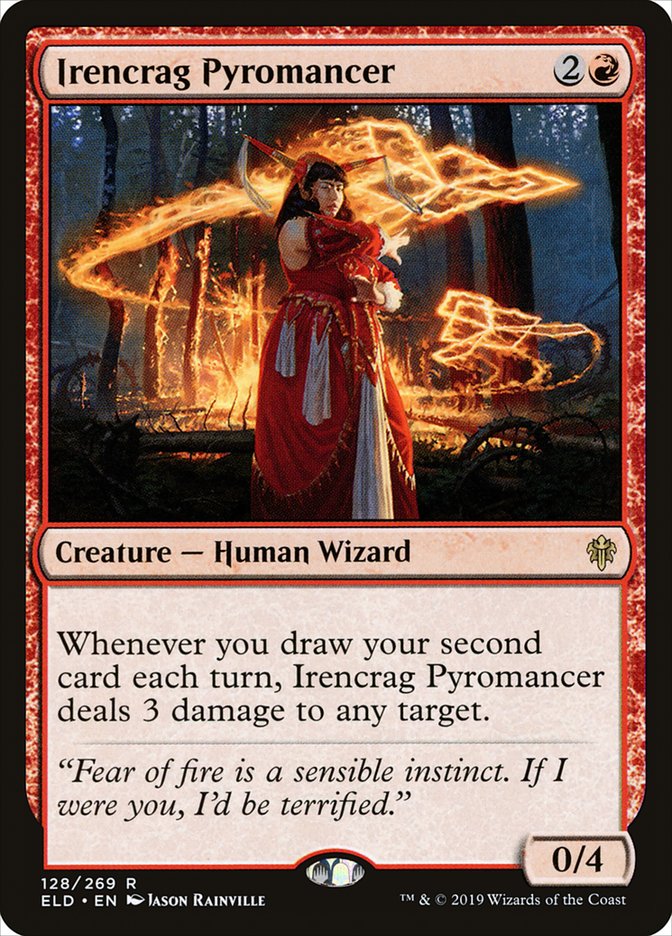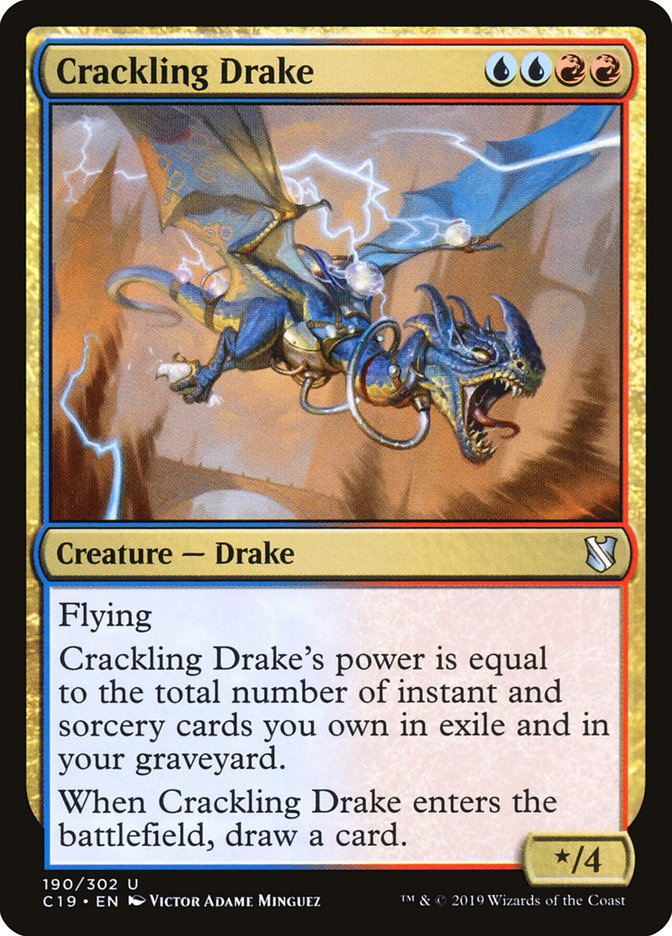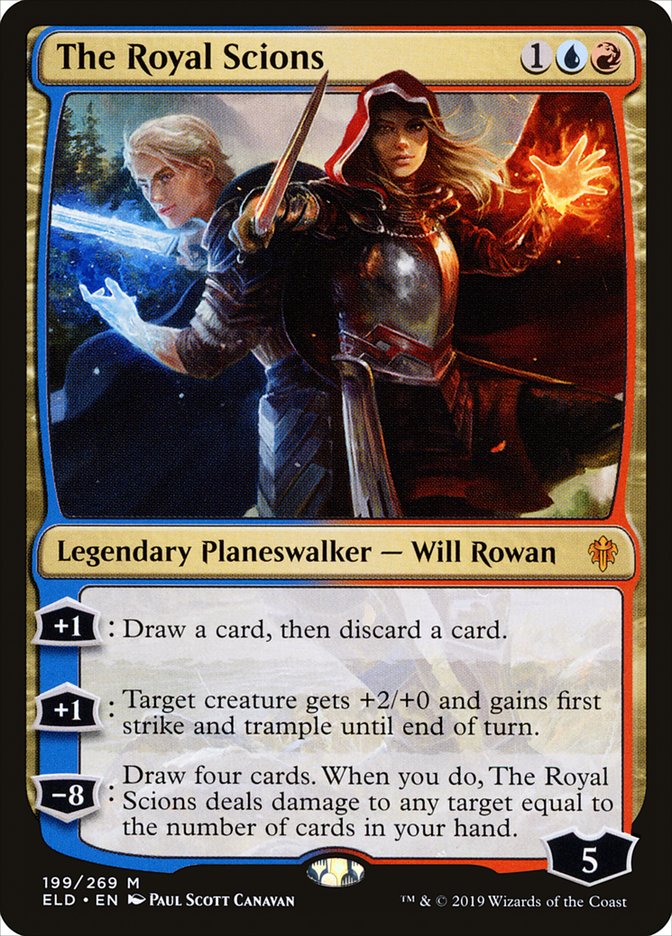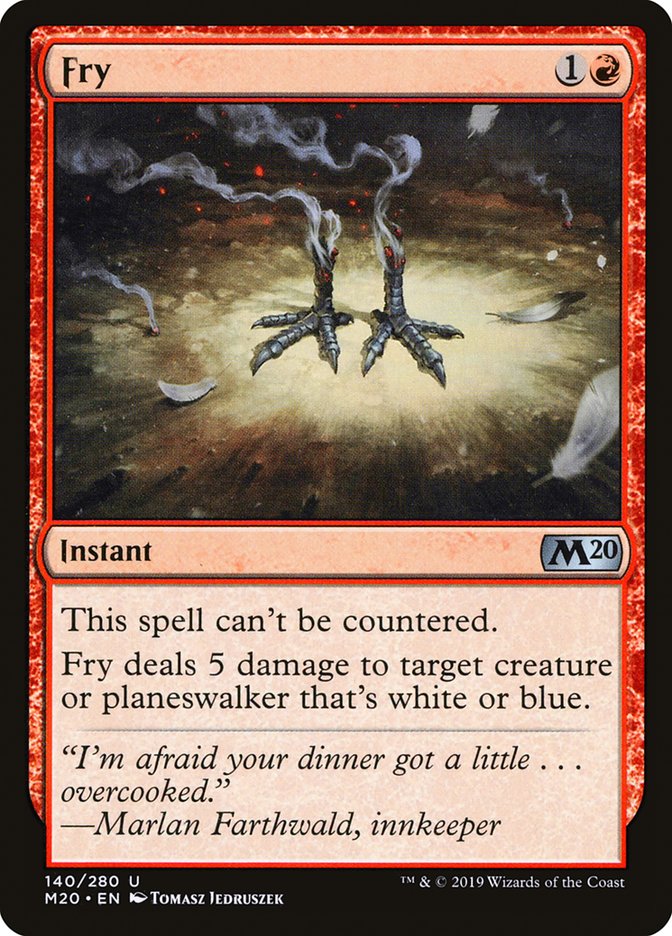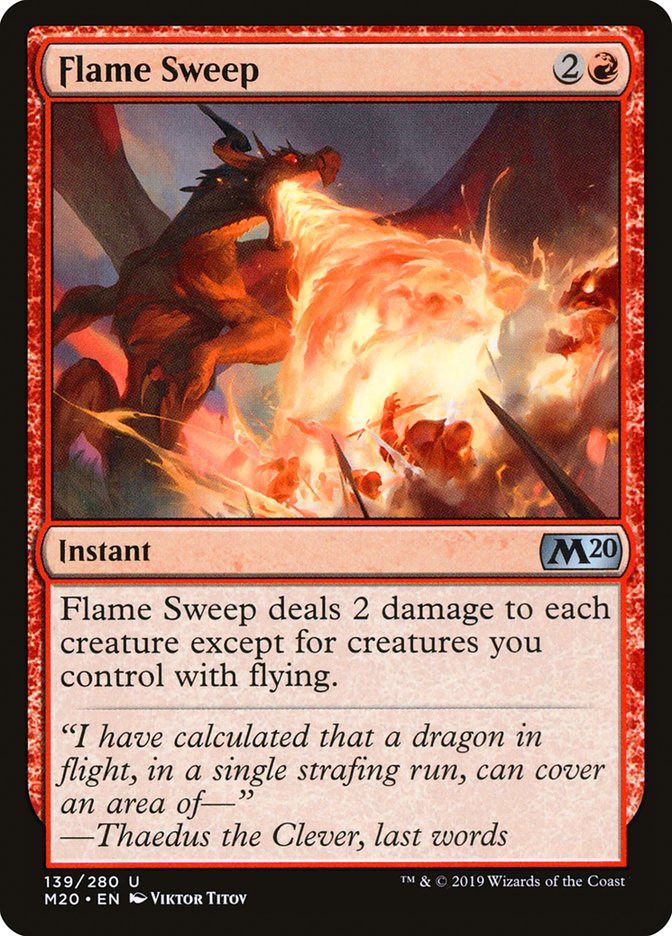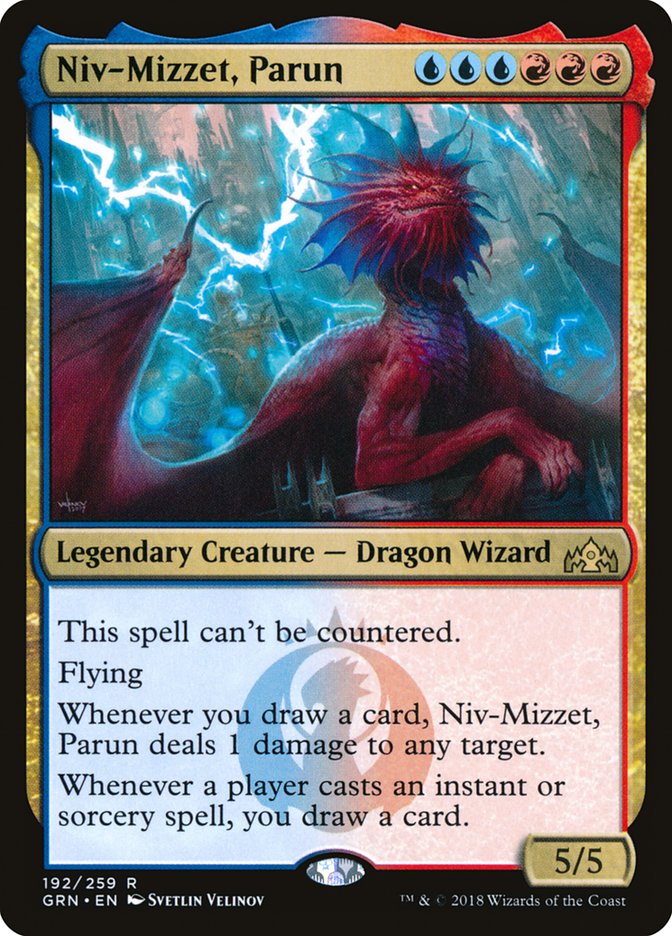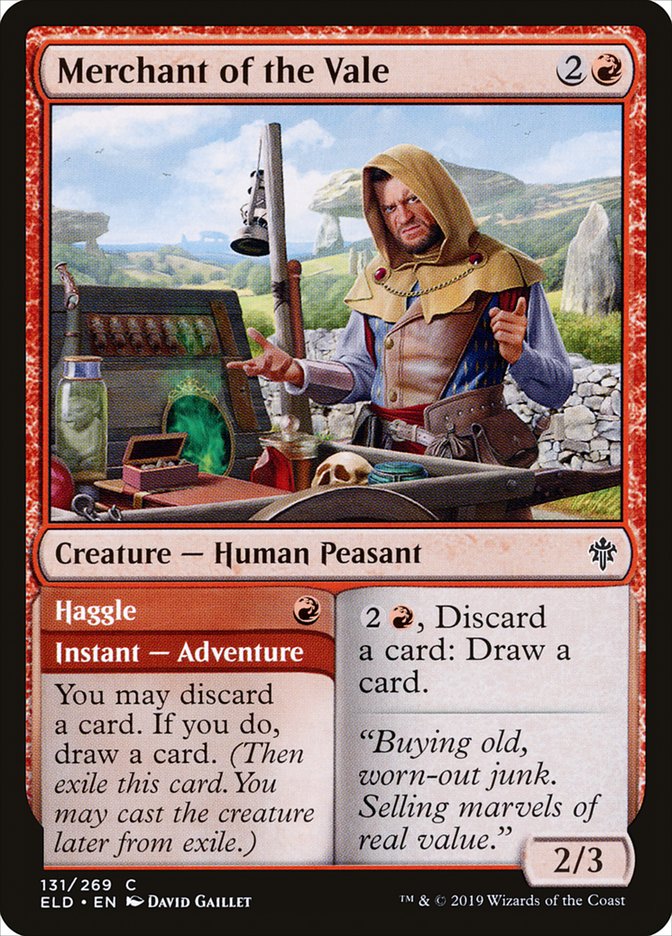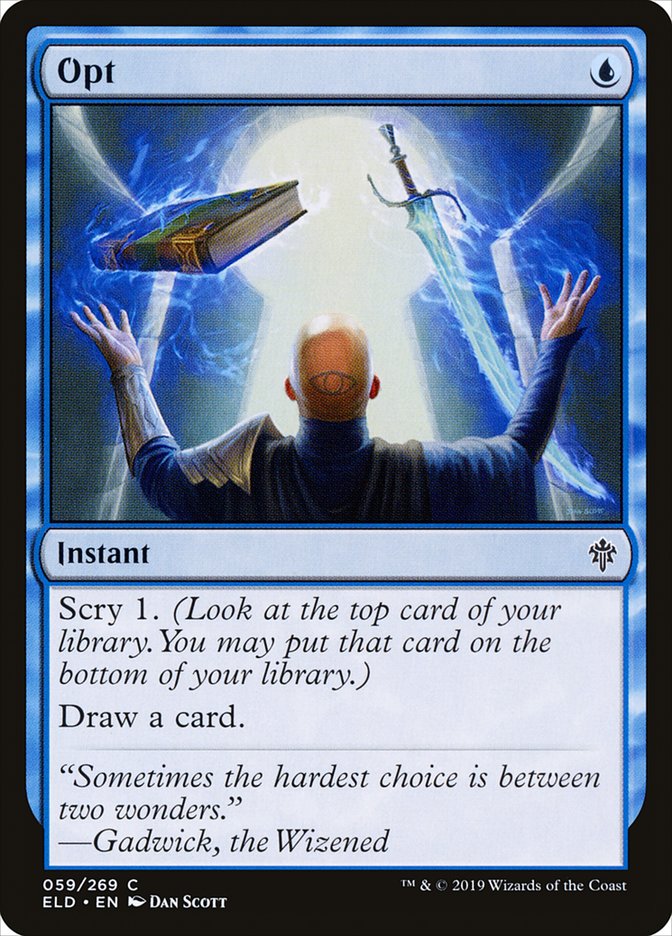I loved working with Todd Anderson on VS Live! over the last year, but the one downside was the fact that he was always the Izzet guy. Todd’s love of Izzet decks is well-known, and I generally deferred to him when a cool spell-centric payoff card was previewed, since that was what he was focusing on anyway.
But man, I love me a nice Izzet deck, too. There’s something so comforting about the consistency provided by a mass of cheap cantrips. Your deck does the same thing game after game, so when the payoffs are there, you are almost guaranteed to have a powerful deck on your hands.
Throne of Eldraine has one such payoff in Irencrag Pyromancer. It’s always tricky trying to evaluate cards like this, but Pyromancer scores highly on my primary heuristic for evaluating synergy-driven payoffs.
The heuristic is you want your payoff to compensate for whatever resources you spend enabling it. If your enablers don’t affect the battlefield, and thus cost you tempo, you need the payoff to make up for that lost tempo and affect the battlefield in a meaningful way. Conversely, if the enablers already affect the battlefield, you want your payoff to generate some card advantage so you can reload for later turns.
In our case, Irencrag Pyromancer will be enabled by cheap cantrips like Opt and Discovery, so the fact that Pyromancer can kill creatures and planeswalkers while we’re otherwise spinning our wheels is excellent. The 0/4 body is also great at holding off creatures on the ground as we’re setting up to pick off those creatures.
So let’s start thinking about enablers. The various cantrips available are obvious, but the dream would be to enable Irencrag Pyromancer with a card that also affects the battlefield. Crackling Drake is the ideal pairing there, since it curves naturally and also plays well with a pile of cantrips, so that pair will form the core of my threat base.
We can also look at one of the new planeswalkers from Throne of Eldraine, The Royal Scions. The looting ability ensures that we’ll get a Lightning Bolt on each of our own turns, which lets us focus on casting other cards rather than just cantrips over and over again. It also fixes our draws, potentially setting up multiple Pyromancers by Turn 5 or 6, which should end the game rather quickly. Pyromancer’s big butt and The Royal Scions’ high loyalty make them relatively easy to protect, and the second +1 ability is excellent with Crackling Drake. On paper this looks to be a very strong core.
The Narset Problem
Something tells me this wasn’t an accident. A planeswalker with a static ability that prevents drawing extra cards printed just before a set with a bunch of payoffs for drawing extra cards is just a little too on the nose to be a coincidence. Narset is a proven powerhouse and should play well in a smaller Standard environment where synergy is less important and decks with good removal and card advantage tend to reign.
Simply put, Narset is going to be a problem for these decks. But it’s far from an insurmountable one.
Fry is a great answer that we can sideboard in high numbers and should also play well against the Knight Tribal decks that are sure to pop up this fall, but I always want to have a proactive answer to problematic cards, rather than relying on having the right spell at the right time.
For attacking Narset, that means having some cheap creatures, and also some haste creatures to attack it immediately in a tempo-positive way. Fortunately red offers an abundance of options on this front; it’ll just be a matter of selecting the right one for a given deck.
On to the lists:
Creatures (12)
Planeswalkers (4)
Lands (23)
Spells (21)
Sideboard

My extra proactive element to stop Narset is Faerie Vandal. It can be awkward on the draw against a Narset, since the planeswalker will stop it from growing, but I want to see if the synergies in the deck can be pushed further, and you only need one or two +1/+1 counters to make Faerie Vandal an excellent threat. Pteramander is another option but it’s hard to adapt it before Turn 5 or so, so it’s not significantly better at attacking Narset, and the flash ability on Faerie Vandal makes it easier to finesse around cheap removal like Shock.
Having a cheap flyer helps enable Winged Words to get a little bit of card advantage into the spell base, but I’m pretty high on how Thrill of Possibility triggers Irencrag Pyromancer on your opponent’s turn, so it wouldn’t be the worst thing to shift towards Thrill in the split and replace Faerie Vandal if it underperforms. For now I like having some card advantage and I’m nervous that overloading on Thrill of Possibility will lead to too many poor topdecks later in the game.
The right land count can be tricky in decks like this. The cantrips enable you to shave lands to an extent, but missing land drops and having to spend a lot of time digging for those lands can leave you too far behind to catch up. I tend to err on the high side, especially when I have access to Temples and a great utility land in Castle Vantress.
In the sideboard, Flame Sweep is excellent since it kills none of our creatures, and I’ve opted for big threats that synergize with Irencrag Pyromancer in Niv-Mizzet, Parun and the singleton The Magic Mirror, which should be relatively easy to cast for four or five mana.
With a strong, proactive gameplan, proven removal, and a powerful planeswalker, there’s a lot to like in this deck. It should be able to adapt to any strategy, playing more defensively against creature decks while grinding value with Pyromancer and clocking control decks while presenting a nice array of threats. Also, unlike mechanics that depend on casting multiple spells, sideboarding is much more straightforward with this deck. You can freely cut removal when it’s bad without worrying about diluting your deck too much, making this much more of a midrange deck with good internal synergy than a true engine deck.
Of course, if we want to go the full engine route, Arclight Phoenix is still around:
Creatures (13)
Planeswalkers (3)
Lands (21)
Spells (23)
Sideboard

Losing Chart a Course is a huge blow to this deck, but The Royal Scions and Thrill of Possibility provide enough discard outlets to make it work, and Irencrag Pyromancer makes the deck less reliant on finding its namesake card early and often. If you find both of them you’re creating a very fast clock. I like having some extra reach in a deck that can peter when your opponent starts casting bigger, more powerful spells and you still have a hand of cantrips and 3/2 flyers.
In addition to its role as a discard outlet for Phoenix, The Royal Scions helps keep the gas flowing to ensure the firebirds keep coming back, and this deck makes great use of the second +1 ability, turning Goblin Electromancer into a substantial threat while letting Arclight Phoenix attack into larger flyers like Crackling Drake and God-Eternal Kefnet.
Some lists of Izzet Phoenix last summer eschewed Goblin Electromancer for Augur of Bolas and instead relied on Finale of Promise to efficiently cast three spells and trigger Arclight Phoenix, but that’s no longer a viable option. There aren’t enough good sorceries to target with the card now that Tormenting Voice and Chart a Course are gone, and Discovery has a converted mana cost of seven, making it prohibitively expensive to target. Without Finale we need Electromancer, though I’ve trimmed a copy since it’s poor in multiples and Irencrag Pyromancer gives the deck another angle of attack, making it less necessary to have the Goblin on Turn 2.
I’ve seen a lot of lists with Merchant of the Vale in order to use Haggle as another discard outlet for Arclight Phoenix, but that card strikes me as well below the barrier to entry, even for a small Standard environment. I don’t want to cast a glorified Riot Devils, so I view it as card disadvantage unless you’re discarding Arclight Phoenix, and between The Royal Scions, Radical Idea, and Thrill of Possibility, we have enough ways to get the Phoenix into our graveyard. Remember, you only want to play cards that are dependent on another card it the synergy is overwhelmingly powerful or if you absolutely have to. Otherwise it’s best to play the cards that stand on their own.
The lower land count here necessitated cutting Castle Vantress and Fabled Passage. Lands that enter the battlefield tapped are a liability here since we often need every bit of mana to cast three spells and it’s paramount to trigger Arclight Phoenix as early as possible.
Lastly, I want to try Irencrag Pyromancer in a shell that isn’t as reliant on a pile of cantrips:
Creatures (3)
Planeswalkers (19)
- 4 Teferi, Time Raveler
- 2 Kasmina, Enigmatic Mentor
- 2 Saheeli, Sublime Artificer
- 4 Narset, Parter of Veils
- 4 Sarkhan the Masterless
- 3 The Royal Scions
Lands (26)
Spells (12)
Sideboard

The bulk of the Jeskai Superfriends deck is surviving rotation, and with Fabled Passage to fix the mana, it could be a powerful deck in the early weeks of Throne Standard. It’s awkward adding a creature to an otherwise creatureless deck and thus giving a target to opposing removal, but Irencrag Pyromancer does a lot of good work here protecting planeswalkers, picking off smaller creatures, and conveniently surviving Deafening Clarion.
Earlier I noted Crackling Drake as a particularly good enabler for Pyromancer since it affects the battlefield, and this deck does the same with Teferi, Time Raveler and Kasmina, Enigmatic Mentor, the latter of which also helps protect Pyromancer from removal. There aren’t as many total ways to draw extra cards, but Narset, Parter of Veils helps dig for them and we still have The Royal Scions to continuously trigger Pyromancer.
The Royal Scions doesn’t have as much utility here as it does in the previous two decks, but it will help you curve out and its high loyalty makes it likely to stick around, ensuring that Sarkhan the Masterless will generate an immediate attacker. Without Karn, Scion of Urza, I’m not as high on Saheeli, Sublime Artificer here, so I’ve trimmed it down to two to make room for The Royal Scions, since the Servos still help protect your planeswalkers while its -2 ability can create an extra Irencrag Pyromancer if you need an extra Lightning Bolt that turn.
I’ve opted to play Fabled Passage to supplement the shocklands as opposed to Temples, since our early spells span all three colors and I’m not that interested in Temple of Triumph in a deck with Narset, Parter of Veils. That leaves us with a little bit less utility from our manabase, but The Royal Scions is excellent protection against flood, so I’m more concerned with a manabase that enables the most consistent draws in the early turns. We aren’t interacting much before Turn 3, so it’s important that we’re functioning properly by then in order to pull ahead.
With all the talk of powerful cards like Irencrag Pyromancer and The Royal Scions, the unsung hero here is Opt. Izzet decks looked to be in a rough spot until the reprint in Throne of Eldraine was revealed, but having a one-mana cantrip of Opt’s quality immediately elevates these decks to the realm of viability. It’s the perfect card to pair with Irencrag Pyromancer on Turn 4, enables early Arclight Phoenix triggers, and sets up the powerful curve of planeswalkers in Jeskai Superfriends. It’s the glue that holds Izzet decks together, and between Izzet Phoenix in Modern, Izzet Phoenix in Standard, and Mono-Blue Aggro in Standard, it’s likely the card I’ve registered and cast the most often over the last year.
May Opt, and by extension spell-based Izzet decks, live on for many years to come.


